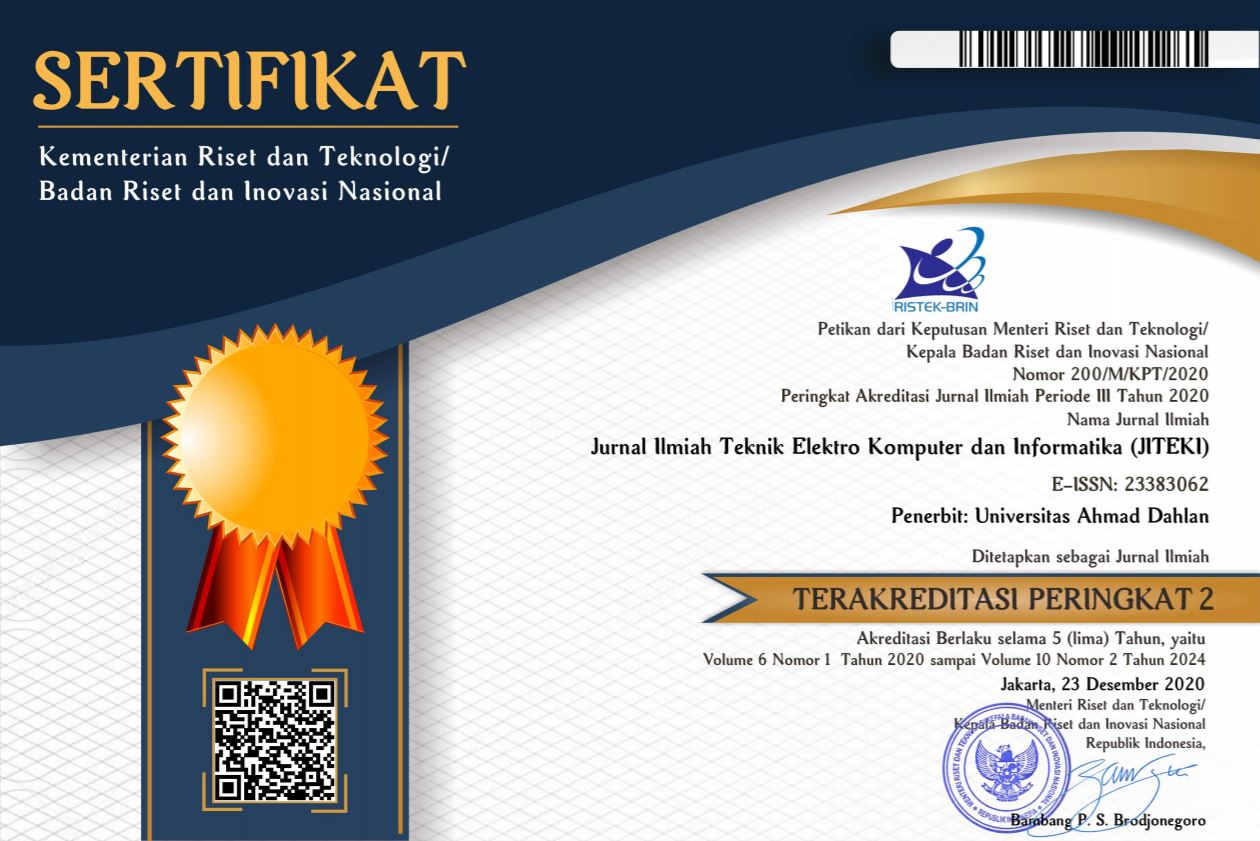Identify The Authenticity of Rupiah Currency Using K Nearest Neighbor (K-NN) Algorithm
DOI:
https://doi.org/10.26555/jiteki.v5i1.13324Keywords:
Identification, Rupiah, GLCM, K-NNAbstract
The rupiah currency is a valid exchange rate used in transactions in the Republic of Indonesia. The Rupiah is often falsified as paper currency. Rupiah paper has a unique texture characteristic so that if processed digitally, it will be easy to distinguish from fake ones. Designing the authenticity of Rupiah currency system using the K-NN method aims to facilitate the authenticity of the currency and test the accuracy of the method used. The method used in this research is the method of Gray Level Co-occurrence Matrix (GLCM) as a method of feature extraction and K-Nearest Neighbor (K-NN) algorithm used in the identification process. The testing phase uses data for 18 currency images. The results showed an accuracy rate of 100% for the value k = 1, 77.78% for the value k = 3, and 55.56% for the value k = 5. The highest level of accuracy in a currency authenticity identification system occurs when the value of k = 1 is 100%. The value of k on the classification input using the K-NN can determine the level of accuracy of the classification process.References
H. Hassanpour, A. Yaseri, and G. Ardeshiri, “Feature extraction for paper currency recognition,†in 2007 9th International Symposium on Signal Processing and Its Applications, 2007, pp. 1–4, doi: 10.1109/ISSPA.2007.4555366.
S. Omatu, M. Yoshioka, and Y. Kosaka, “Reliable Banknote Classification Using Neural Networks,†in 2009 Third International Conference on Advanced Engineering Computing and Applications in Sciences, 2009, pp. 35–40, doi: 10.1109/ADVCOMP.2009.37.
N. Jahangir and A. R. Chowdhury, “Bangladeshi banknote recognition by neural network with axis symmetrical masks,†in 2007 10th international conference on computer and information technology, 2007, pp. 1–5, doi: 10.1109/ICCITECHN.2007.4579423.
C. Chang, T. Yu, and H. Yen, “Paper Currency Verification with Support Vector Machines,†in 2007 Third International IEEE Conference on Signal-Image Technologies and Internet-Based System, 2007, pp. 860–865, doi: 10.1109/SITIS.2007.146.
J. Qian, D. Qian, and M. Zhang, “A Digit Recognition System for Paper Currency Identification Based on Virtual Instruments,†in 2006 International Conference on Information and Automation, 2006, pp. 228–233, doi: 10.1109/ICINFA.2006.374117.
P. T. Noi and M. Kappas, “Comparison of Random Forest, k-Nearest Neighbor, and Support Vector Machine Classifiers for Land Cover Classification Using Sentinel-2 Imagery,†Sensors, vol. 18, no. 18, pp. 1–20, 2018, doi: 10.3390/s18010018.
V. Bijalwan, V. Kumar, P. Kumari, and J. Pascual, “KNN based Machine Learning Approach for Text and Document Mining,†Int. J. Database Theory Appl., vol. 7, no. 1, pp. 61–70, 2014, available at: Google Scholar.
K. Huang, S. Li, X. Kang, and L. Fang, “Spectral – Spatial Hyperspectral Image Classification Based on KNN,†Sens. Imaging, vol. 17, no. 1, pp. 1–13, 2016, doi: 10.1007/s11220-015-0126-z.
K. Machhale, H. B. Nandpuru, V. Kapur, and L. Kosta, “MRI brain cancer classification using hybrid classifier (SVM-KNN),†in 2015 International Conference on Industrial Instrumentation and Control (ICIC), 2015, pp. 60–65, doi: 10.1109/IIC.2015.7150592.
H. Zhang, A. C. Berg, M. Maire, and J. Malik, “SVM-KNN: Discriminative Nearest Neighbor Classification for Visual Category Recognition,†in 2006 IEEE Computer Society Conference on Computer Vision and Pattern Recognition (CVPR’06), 2006, vol. 2, pp. 2126–2136, doi: 10.1109/CVPR.2006.301.
Z. Deng, X. Zhu, D. Cheng, M. Zong, and S. Zhang, “Efficient kNN classification algorithm for big data,†Neurocomputing, vol. 195, pp. 143–148, 2016, doi: 10.1016/j.neucom.2015.08.112.
T. M. Cover and P. E. Hart, “Nearest Neighbor Pattern Classification,†IEEE Trans. Inf. THEORY, vol. IT-13, no. 1, pp. 21–27, 2018, doi: 10.1109/TIT.1967.1053964.
C. H. Wan, L. H. Lee, R. Rajkumar, and D. Isa, “A hybrid text classification approach with low dependency on parameter by integrating K-nearest neighbor and support vector machine,†Expert Syst. Appl., vol. 39, no. 15, pp. 11880–11888, 2012, doi: 10.1016/j.eswa.2012.02.068.
S. Zhang, X. Li, M. Zong, X. Zhu, and R. Wang, “Efficient kNN Classification With Different Numbers of Nearest Neighbors,†IEEE Trans. Neural Networks Learn. Syst., vol. 29, no. 5, pp. 1774–1785, 2018, doi: 10.1109/TNNLS.2017.2673241.
A. S. R. M. Sinaga, “The Comparison of Signature Verification Result Using 2DPCA Method and SSE Method,†Int. J. Artif. Intelegence Res., vol. 2, no. 1, pp. 18–27, 2018, doi: 10.29099/ijair.v2i1.38.
R. M. Haralick and K. Shanmugam, “Textural Features for Image Classification,†IEEE Trans. Syst. MAN, Cybern., vol. SMC-3, no. 6, pp. 610–621, 1973, doi: 10.1109/TSMC.1973.4309314.
G. Guo, H. Wang, D. Bell, and Y. Bi, “KNN Model-Based Approach in Classification,†Aug. 2004, available at: https://link.springer.com/chapter/10.1007/978-3-540-39964-3_62.
Downloads
Published
How to Cite
Issue
Section
License
Authors who publish with JITEKI agree to the following terms:
- Authors retain copyright and grant the journal the right of first publication with the work simultaneously licensed under a Creative Commons Attribution License (CC BY-SA 4.0) that allows others to share the work with an acknowledgment of the work's authorship and initial publication in this journal.
- Authors are able to enter into separate, additional contractual arrangements for the non-exclusive distribution of the journal's published version of the work (e.g., post it to an institutional repository or publish it in a book), with an acknowledgment of its initial publication in this journal.
- Authors are permitted and encouraged to post their work online (e.g., in institutional repositories or on their website) prior to and during the submission process, as it can lead to productive exchanges, as well as earlier and greater citation of published work.

This work is licensed under a Creative Commons Attribution 4.0 International License

